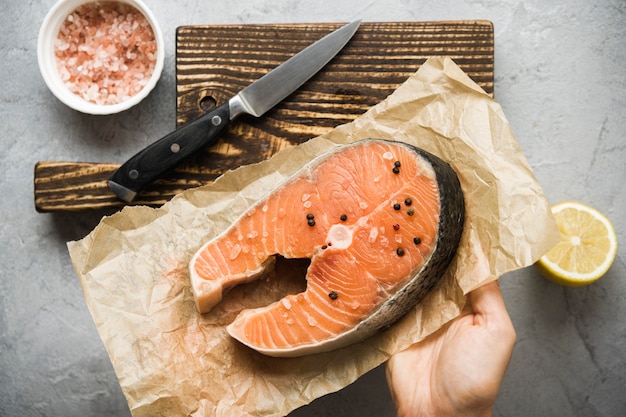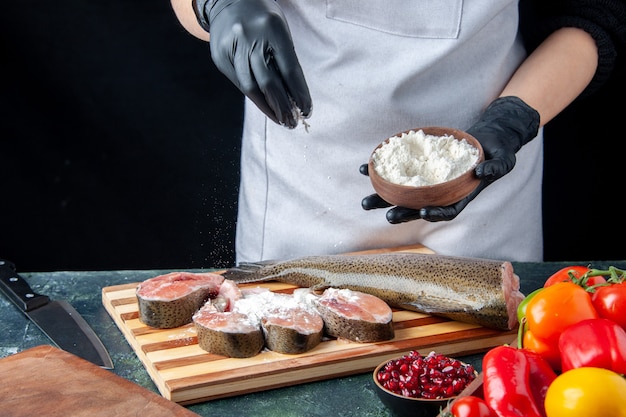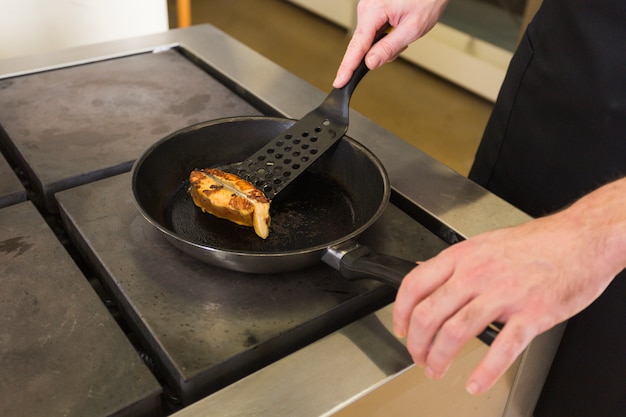I’ve always loved the simplicity of a perfectly pan-seared salmon fillet. It's a dish that feels both elegant and comforting, with a delicate flavour that's easily elevated. But as someone who’s spent years experimenting in the kitchen, I know all too well how easy it is to get it wrong. A dry, overcooked fillet is a tragedy, and I've definitely had my fair share of those.
So, I'm here to share the secrets I've learned over the years, the little tricks that guarantee juicy, melt-in-your-mouth salmon every time. We'll cover everything from choosing the right fish to nailing the pan-searing technique, and even explore some creative ways to serve it up. Buckle up, because we're about to dive into the world of pan-seared salmon perfection.
(Part 1) choosing the right salmon

Let's start at the beginning – choosing the right salmon. Just like a good foundation is essential for a sturdy house, the right fish is the key to a delicious dish. So, let's break down the essentials.
1. Freshness is Key
I'm a big believer in fresh ingredients. You know that feeling when you bite into a juicy tomato that's bursting with flavour? That’s what we’re aiming for with our salmon. Look for fillets that are firm and springy to the touch. If you press your finger on the flesh and it doesn't bounce back, it's a sign that the salmon isn’t as fresh as it could be. You also want to make sure the colour is a healthy pink or reddish-orange, and there are no signs of discolouration or bruising. And, a little fishy smell is normal, but if it’s overpowering, it's best to steer clear.
2. Know Your Salmon
There's a whole world of salmon out there, each with its own unique flavour and texture. For pan-searing, I'm a big fan of wild-caught salmon. It tends to have a richer flavour and a firmer texture, which is perfect for getting that beautiful, crispy skin. But, don't discount farmed salmon. It's a perfectly valid option, especially if you’re on a budget. Just be aware that it can be a bit softer and might break apart more easily when you cook it.
3. Skin On or Skin Off?
That's a question that's been debated for ages. I prefer skin-on salmon for pan-searing. The skin acts as a protective barrier, preventing the delicate flesh from drying out and sticking to the pan. Plus, it adds a lovely bit of crunch to the finished dish. But, if you're not a fan of the skin, go ahead and remove it. Just make sure you pat the fillet dry with paper towels to ensure it gets nice and crispy.
(Part 2) The Art of Seasoning

Okay, you’ve got your perfect salmon fillets. Now it’s time to get creative with the seasoning. This is where you can truly express your personal style and bring your own unique flavour to the dish. So, let's dive into the world of spices, herbs, and citrus zest.
1. The Basics
I always start with salt and pepper. It’s the foundation of any good seasoning, bringing out the natural flavours of the salmon without overpowering it. But don't go crazy with the salt. We're aiming for a subtle touch, just enough to enhance the flavour, not to make it salty.
2. Adding Some Zing
For a bright, refreshing flavour, I love to add a bit of citrus zest. Lemon zest is a classic, but I’ve also been known to experiment with lime or even orange zest. The key is to grate it finely. You don't want any large pieces of zest getting in the way of the beautiful salmon flesh.
3. Herbs of Choice
Fresh herbs are an absolute must! It's like adding a burst of sunshine to the dish. I often reach for dill, parsley, or chives, but feel free to experiment with your favourites. Thyme and rosemary can add a lovely earthy depth of flavour. And, if you're feeling adventurous, try a sprinkle of tarragon or basil. The possibilities are endless!
4. Spice it Up
For those who enjoy a bit of heat, a pinch of chili flakes or a sprinkle of paprika can really add a kick. But remember, we're aiming for a subtle touch. A little spice goes a long way. If you're not sure, start with a tiny amount and add more to taste. And, if you want something more complex, try a blend of spices like cumin, coriander, and turmeric.
(Part 3) The Pan-Searing Technique

Now we’re getting to the heart of it, the moment of truth – the pan-searing. This is where the magic happens, where the salmon transforms from a raw fillet into a golden, crispy masterpiece. But be warned, pan-searing requires a bit of precision and a steady hand. Let’s break it down step-by-step.
1. A Hot Pan is Key
The key to perfect pan-searing is heat. We’re aiming for a hot, sizzling pan that will create a beautiful crust on the salmon. I prefer to use a cast iron pan. It heats up quickly and evenly, ensuring a perfectly cooked fillet. Once the pan is nice and hot, add a generous amount of oil. Don't be shy, we want enough to create a thin, even layer across the bottom of the pan.
2. Don’t Crowd the Pan
Don’t try to cram all your salmon fillets into the pan at once. Give them some space to breathe! If the pan is too crowded, the salmon won't cook evenly and you might end up with soggy fillets. If you have more than two fillets, cook them in batches.
3. The Golden Rule
Place the salmon fillets in the pan, skin side down. This is crucial for achieving that crispy, golden skin. Let it cook undisturbed for about 3-4 minutes. You'll know it's ready when the skin is crispy and a beautiful golden brown.
4. Flipping the Fish
Now comes the moment of truth. Gently flip the salmon over. Use a thin spatula to gently lift it, making sure to avoid breaking the delicate flesh. Cook for another 2-3 minutes, or until the flesh is opaque and flakes easily when you gently press it with a fork. Don’t overcook it! We want the salmon to be juicy and tender, not dry and tough.
5. The Final Touch
When it’s done, remove the salmon from the pan and let it rest for a few minutes. This allows the juices to redistribute, making for a more tender and flavorful fillet. You can serve it immediately, but I like to let it rest for at least 5 minutes.
(Part 4) Serving Suggestions
Your perfectly pan-seared salmon is ready! Now for the fun part - how to serve it. Here are a few ideas to get your creative juices flowing, from classic combinations to more adventurous pairings.
1. A Classic Combination
Let's start with a classic – pan-seared salmon with roasted vegetables. roasted asparagus, broccoli, or Brussels sprouts are always a good choice. The combination of the rich salmon flavour with the smoky, caramelized vegetables is simply irresistible.
2. A Touch of Luxury
For a touch of luxury, try serving your salmon with a creamy lemon sauce. Just whisk together some butter, lemon juice, and a little cream. The tanginess of the lemon cuts through the richness of the salmon and butter, creating a harmonious balance of flavours. It's simple to make, yet incredibly delicious.
3. A Flavorful Salad
For a lighter option, try serving your salmon over a bed of greens. Add some chopped tomatoes, cucumbers, and red onions for a refreshing salad. You can even add a few toasted walnuts or pecans for a bit of crunch.
4. A Spicy Kick
For a spicy twist, try serving your salmon with a mango salsa. It's the perfect blend of sweet, spicy, and tangy flavours. The mango adds a tropical sweetness, the red onion provides a bit of sharpness, and the jalape??o adds a touch of heat. It's the perfect topping for a pan-seared salmon fillet.
(Part 5) Sides that Complement the Dish
So, you've got your perfectly pan-seared salmon, but what about the sides? Here are some ideas that will compliment the flavour of your salmon, adding depth and complexity to the dish.
1. Rice: The Classic Choice
A bed of white rice is a classic choice for any seafood dish. It's simple, neutral, and complements the flavour of the salmon beautifully. You can even add a squeeze of lemon or a drizzle of soy sauce for a touch of flavour. Or, get adventurous with wild rice or brown rice for a more complex flavour.
2. Quinoa: A Healthy Option
Quinoa is a great alternative to rice if you're looking for a healthier option. It's packed with protein and fiber, and its slightly nutty flavour pairs well with the salmon. You can add a bit of chopped parsley or a sprinkle of toasted sesame seeds for a bit of extra flavour.
3. Pasta: A Hearty Choice
For a heartier dish, try serving your salmon with pasta. Linguine or fettuccine are good choices, but you can use any pasta you like. Toss the pasta with a light sauce, like a lemon-butter sauce or a simple tomato sauce. And, don't forget to add a sprinkle of grated Parmesan cheese for a touch of richness.
4. Roasted Vegetables: A Healthy and Flavorful Option
Roasted vegetables are a great way to add colour and flavour to your meal. Roasted asparagus, broccoli, carrots, or Brussels sprouts all go well with salmon. Just toss them with olive oil, salt, and pepper, and roast them in the oven until tender. The sweetness of the roasted vegetables will perfectly complement the richness of the salmon.
(Part 6) FAQs
Now, for the burning questions. The ones that keep you up at night, tossing and turning. Don’t worry, I've got you covered. I've compiled a list of the most frequently asked questions about pan-seared salmon to help you conquer any cooking conundrum.
1. How do I know if the salmon is cooked through?
The best way to check is to insert a fork into the thickest part of the fillet. If the flesh flakes easily, it’s cooked through. If it's still a bit pink, it needs to cook a bit longer. But remember, salmon should be cooked to an internal temperature of 145°F (63°C) for food safety.
2. What happens if I overcook the salmon?
overcooked salmon becomes dry and tough. It's not the end of the world, but it's definitely not as enjoyable. The best thing to do is to try not to overcook it in the first place. Use a timer and check the fish frequently. And, if you do overcook it, try adding a little bit of lemon juice or cream to help rehydrate the flesh.
3. Can I pan-sear frozen salmon?
You can, but it's not ideal. Frozen salmon tends to be more watery and may fall apart during cooking. It’s best to thaw it out in the refrigerator overnight before cooking. This will give the salmon time to defrost evenly, preventing it from becoming too soggy during cooking.
4. What if the salmon sticks to the pan?
If the salmon sticks, don't panic! Just try to loosen it gently with a spatula. If it's really stuck, you can add a little more oil to the pan. Make sure the pan is hot enough before adding the salmon. And, if you're using a non-stick pan, make sure it's well-seasoned and clean.
5. Can I pan-sear salmon in a non-stick pan?
Yes, you can. Just make sure the pan is hot enough before adding the salmon. And don't be afraid to use a little oil to prevent sticking. Non-stick pans are great for avoiding sticking, but they don't always get as hot as cast iron pans, so you might need to cook the salmon for a little longer.
(Part 7) Tips for a Successful Pan-Seared Salmon
Now, here are a few extra tips that will help you achieve those perfect, juicy fillets. They might seem small, but they can make a big difference in the final result.
1. Don't over-season
A little seasoning goes a long way. Remember, you want to enhance the natural flavour of the salmon, not mask it. If you're unsure, start with a small amount of seasoning and add more if needed. You can always add more, but you can't take it away once it's in.
2. Use high-quality oil
Olive oil is a classic choice for pan-searing salmon. It has a nice flavour and a high smoke point, which means it can handle the heat of the pan without burning. But, if you prefer a neutral flavour, try avocado oil or grapeseed oil. Whatever oil you choose, make sure it's fresh and high quality.
3. Rest the salmon before serving
This is an essential step that many people overlook. Resting the salmon allows the juices to redistribute, resulting in a more tender and flavorful fillet. Just let it sit for a few minutes before serving. And, while it's resting, you can prepare the rest of your meal.
4. Use a meat thermometer
If you're unsure whether the salmon is cooked through, use a meat thermometer to check the internal temperature. Salmon is considered safe to eat when it reaches an internal temperature of 145°F (63°C). This is especially important if you're serving it to guests or have any concerns about food safety.
5. Don't be afraid to experiment
The beauty of cooking is that there are no hard and fast rules. Don't be afraid to experiment with different seasonings, sauces, and sides to find what you like best. It's all about finding what works for you and your taste buds. So, go wild!
(Part 8) Beyond Pan-Searing
Okay, so you've mastered the art of pan-searing salmon. But let’s talk about other ways to cook it. Because who wants to be limited to just one technique? Let's explore some alternative cooking methods that will expand your culinary repertoire.
1. Oven Baking
If you prefer to cook your salmon in the oven, this is a great option. Just preheat your oven to 400°F (200°C). Place the salmon on a baking sheet lined with parchment paper. Bake for 12-15 minutes, or until the flesh is opaque and flakes easily. You can also add a drizzle of olive oil and a sprinkle of herbs for extra flavour.
2. Grilling
Grilling is a great way to add smoky flavour to your salmon. Just preheat your grill to medium heat. Place the salmon on the grill, skin side down, and cook for 3-4 minutes. Flip the salmon and cook for another 2-3 minutes, or until the flesh is opaque and flakes easily. You can even add some wood chips to your grill for a more intense smoky flavour.
3. Poaching
Poaching is a gentler cooking method that results in a moist and delicate salmon. Bring a pot of water to a simmer. Add some aromatics, like lemon slices, bay leaves, and peppercorns. Add the salmon to the pot and cook for 10-12 minutes, or until the flesh is opaque and flakes easily. You can serve the poached salmon with a light sauce or a simple salad.
(Part 9) Final Thoughts
Well, there you have it. My ultimate guide to pan-searing salmon. I've shared my secrets, my tips, my love for this delicious fish. Remember, cooking is a journey, not a destination. So, don't be afraid to try new things, experiment with different flavours, and find what works best for you.
Now, go out there, grab some fresh salmon, and whip up a delicious meal that will impress your family and friends. I'm sure you’ll be a pan-searing pro in no time! And, remember to have fun with it. Cooking should be a joyful experience.
Everyone is watching

How to Cook Frozen Lobster Tails Perfectly: A Step-by-Step Guide
RecipesLobster. Just the word conjures up images of lavish meals, special occasions, and a taste of luxury. But let's...

Pigs in a Blanket Cooking Time: How Long to Bake for Perfect Results
RecipesAh, pigs in a blanket. Just the name conjures up images of those delightful little parcels of crispy pastry en...

Pork Fillet Cooking Time: How Long to Cook It Perfectly
RecipesPork fillet, or tenderloin as it's sometimes called, is a real favourite in our house. It's so versatile, and...

The Ultimate Guide to Cooking Delicious Frankfurters
RecipesLet's face it, we all love a good frankfurter. It's a classic, simple, and always satisfying. But let's be rea...

Wolf Meat Recipes: A Guide to Cooking Wild Game
RecipesLet's be honest, you don't see wolf meat at your local butcher shop every day. It's a bit of a wild card, but ...
